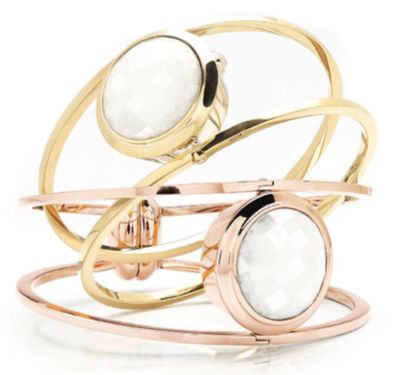Berkshire Hathaway jumps into wearables with a smart jewelry line


Berkshire Hathaway, the multinational conglomerate led by Warren Buffet, owns businesses in just about every industry imaginable, from retail to railroads. It may come as no surprise, then, that its jewelry subsidiary, the Richline Group, has plans to extend its own empire into a new realm -- wearables.
This spring, the jewelry manufacturer and distributor is launching a smart jewelry line called Ela. Starting with wristwear, Ela is the Richline Group's first foray into wearables, which should eventually extend into multiple product categories like rings and earrings.
Using Bluetooth Low Energy, Ela connects to both iOS and Android devices. It has a step-tracking feature that syncs with Apple Health and Google Health Kit. However, the company was interested in producing something better than just a "prettier step tracker," Cliff Ulrich, product innovation manager for the Richline Group, explained to ZDNet. The wearable also connects to the Ela app, through which you can create and share photos and other "memories" like special songs or a voice recording. The memories can be pre-loaded when giving it as a gift to someone else. A user can also create alerts -- the gem on the device will softly glow and vibrate when someone on your alert list is trying to contact you. Users can set the device to glow a certain color for specific contacts or groups.
The wearables market has yet to gain real traction in the US, particularly when it comes to wearable products outside of smartwatches or fitness bands. As of December, just over 15 percent of Americans owned a smartwatch or fitness band, according to Kantar, and only 8 percent of non-owners said they planned to buy a wearable device in the next year.
Smartwatches less than one-third of all wearables in US:
Even so, there's optimism in the tech industry that the market will grow and diversify. For a traditional jewelry company like the Richline Group, the expansion into wearables is a strategic move that's both offensive and defensive.
AR + VR
The share of discretionary spending on jewelry is shrinking compared to how much consumers are spending on electronics and experiences, Ulrich explained. Seeing those trends, he explained, the firm asked, "How can we continue to push forward and continue our growth for the next 10-plus years?"
While there's been plenty of hype around wearables, "we have more tempered expectations for sustainable growth," Ulrich said. "We know that the jewelry industry is very different from electronics."
It does, however, have similarities to the watch market, which was jolted by the Apple Watch. While the Apple Watch is relegated to the "other products" category on Apple's earnings report, Apple is now the No. 2 watch company in the world, second in sales only to Rolex.
Soon, Ulrich said, wearables "will somewhat start to cannibalize some of the jewelry industry as it has the watch market."
That's why the Richline Group designed Ela -- a wearable device that not only taps into consumers' growing interest in electronics, but also their interest in spending on "experiences."
"Jewelry is a lot about sharing special moments," Ulrich said. "We wanted to create the modern day locket and allow people to store memories in their jewelry... If someone wants all the features in the world, they'll get a smartwatch. But we tried to create a much more emotional connection with a product, rather than being purely about the functionality."
The Ela line also emphasizes design. The line launches in April with four different designs and various color combinations to choose from. The bracelets will cost between $195 and $295, depending on the design and the intrinsic value of the materials (it will be available in options including stainless steel, silver, and gold).
While jewelry design is, not surprisingly, one of the Richline Group's core competencies, the company last year acquired the wearables firm Viawear to help develop the technology powering Ela.
After the Richline Group was acquired itself by Berkshire Hathaway in 2007, it gave the company more freedom, Ulrich said, to expand into new areas both through acquisitions and internal initiatives. "We're always encouraged by headquarters to think five, 10 years down the road and beyond, and not just about this quarter's profits," he said.